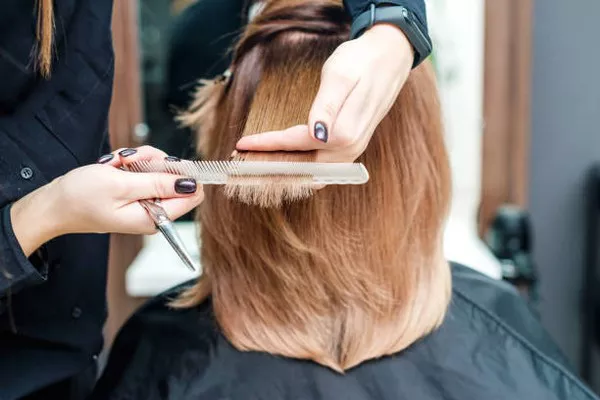Thin hair can be a challenge, but with the right hairstyles, you can create the illusion of thicker, fuller locks. Understanding which hairstyles can add volume and dimension to your hair can transform your look and boost your confidence. This article will explore 6 hairstyles that can make your hair look thicker, including the reasons why they work and detailed analysis on how to achieve them.
1. Layered Haircuts
Why Layers Work
Layered haircuts are a go-to style for adding volume and movement to thin hair. By cutting the hair at different lengths, layers create the illusion of depth and fullness. The shorter top layers help lift the hair, while the longer bottom layers provide weight and structure.
Detailed Analysis
Cutting Technique: When getting a layered haircut, it’s essential to communicate with your stylist about the desired volume and shape. Razor cutting or point cutting techniques can be used to create soft, textured ends that blend seamlessly.
Styling Tips: Use a volumizing mousse or spray at the roots before blow-drying your hair upside down. This will enhance lift and body. Additionally, using a round brush can help create volume and smoothness.
Maintenance: Regular trims are crucial to maintaining the shape and preventing split ends, which can make hair look thinner.
2. Bob Hairstyles
Why Bobs Work
Bobs are versatile and can be tailored to suit various face shapes and hair types. A well-cut bob can make thin hair appear denser by creating a blunt, even line that gives the illusion of thicker hair.
Detailed Analysis
Types of Bobs:
Classic Bob: A chin-length bob with a blunt cut is perfect for adding volume at the ends.
A-Line Bob: Longer in the front and shorter in the back, this style adds dimension and body.
Textured Bob: Adding slight layers or texturing the ends can provide movement and prevent the style from looking too heavy.
Styling Tips: Blow-dry your hair using a round brush to add volume at the roots and smooth out the ends. A texturizing spray or sea salt spray can add a tousled effect for more volume and movement.
Maintenance: Bobs require regular trims to maintain their shape and prevent the ends from becoming ragged.
3. Pixie Cuts
Why Pixie Cuts Work
Pixie cuts can be incredibly flattering for thin hair because they focus on the texture and shape of the hair. Shorter hair naturally stands up more, creating the illusion of fullness.
Detailed Analysis
Cutting Technique: A pixie cut should have varying lengths on top to add texture and volume, with shorter sides and back. Using a razor or point cutting can add softness and prevent the cut from looking too severe.
Styling Tips: Use a lightweight styling product like a mousse or texturizing spray to enhance the natural texture. Blow-dry your hair using your fingers to lift the roots and add volume. Finish with a light wax or pomade for definition.
Maintenance: Pixie cuts need frequent trims to keep their shape and prevent the style from becoming overgrown.
4. Long Layers with Face-Framing Pieces
Why Long Layers Work
Long layers with face-framing pieces can add movement and dimension to thin hair without sacrificing length. The layers help distribute weight and prevent hair from looking flat.
Detailed Analysis
Cutting Technique: Ask your stylist for long layers that start around the chin, gradually blending into the rest of your hair. Face-framing layers should be cut to enhance your facial features and add dimension.
Styling Tips: Use a volumizing shampoo and conditioner to prep your hair. Blow-dry with a round brush, lifting the hair at the roots for added volume. You can also use a curling iron to create loose waves, which add texture and fullness.
Maintenance: Regular trims are essential to keep the layers looking fresh and prevent split ends.
See Also: What Hairstyles Are Best for Thick Hair
5. Side-Swept Bangs
Why Side-Swept Bangs Work
Side-swept bangs can add volume and interest to your hairstyle. They draw attention to the eyes and cheekbones while adding a sense of thickness to the front of your hair.
Detailed Analysis
Cutting Technique: The bangs should be cut at a slight angle, starting shorter at the part and gradually getting longer towards the opposite side. This creates a soft, sweeping effect.
Styling Tips: Blow-dry your bangs with a round brush, directing them to the side for a voluminous, swooping effect. Use a light hairspray to keep them in place without making them stiff.
Maintenance: Regular trims are necessary to maintain the length and shape of the bangs.
6. Beachy Waves
Why Beachy Waves Work
Beachy waves add texture and volume to thin hair, making it look fuller and more voluminous. The tousled effect creates an illusion of thickness by adding dimension.
Detailed Analysis
Creating Beachy Waves: Use a curling iron or wand with a medium barrel to create loose waves. Wrap sections of hair around the barrel, holding for a few seconds before releasing. Alternate the direction of the curls for a natural look.
Styling Tips: Apply a sea salt spray or texturizing spray to damp hair before blow-drying. After curling, use your fingers to tousle the waves and break them up for a more natural appearance. Finish with a light hairspray to hold the waves in place.
Maintenance: Beachy waves can be maintained with minimal effort. A touch-up with a curling iron or texturizing spray can revive the style between washes.
Conclusion
Choosing the right hairstyle can significantly impact the appearance of thin hair. Layered haircuts, bob hairstyles, pixie cuts, long layers with face-framing pieces, side-swept bangs, and beachy waves are all excellent options for creating the illusion of thicker, fuller hair. Understanding the cutting techniques, styling tips, and maintenance required for each style can help you achieve the desired volume and confidence in your look. With these hairstyles, you can transform your thin hair into a voluminous, stylish masterpiece.


